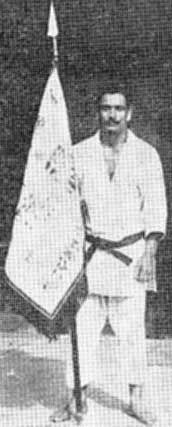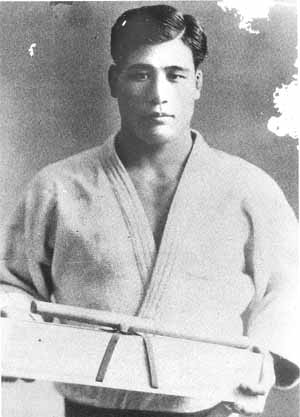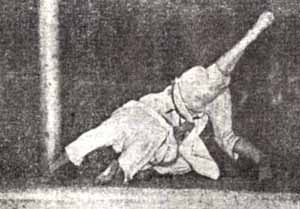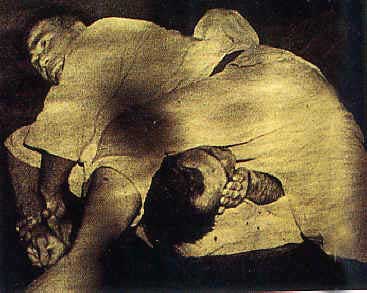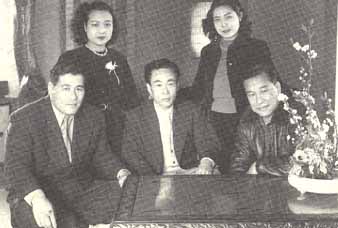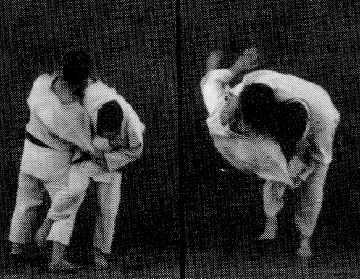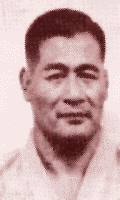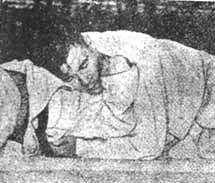The Man Who Defeated Helio Gracie
By Jim Chen M.D.
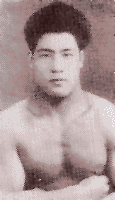 In 1937 Masahiko Kimura won the All Japan Championship at age 20. For the next 13 years he was undefeated before he retired.
5th Dan at age 18 Kimura (5’6″, 170cm; 85kg, 187lbs) was born on September 10, 1917 in Kumamoto, Japan. At age 16, after 6 years of judo, he was promoted to 4th dan. He had defeated 6 opponents (which were all 3rd and 4th dan) in a row. In 1935 at age 18 he became the youngest ever godan (5th degree black belt) when he defeated 8 consecutive opponents at Kodokan.
Kimura 4 Lifetime Losses In the spring of 1935 at the Kohaku Shiai (Kodokan Red-White Team Competition), Kimura defeated 8 opponents. In his 9th fight he lost to Miyajima (a student from Meiji University) by Haraigoshi. In May of 1935 Kimura fought Kenichiro Osawa at the 5th dan division championship. Kimura attacked with an Ouchigari to Osotogari combination. Osawa countered Kimura with such force that Kimura suffered a concussion. In his second match at the 5th dan championship he fought Kenshiro Abe (5’5″‘, 168cm; 156lbs, 71kg). Abe was so skillful that Kimura felt as if he was fighting a shadow. Every throw he tried (Osoto, Seoi) had no effect at all. Abe countered with Uchimata, Hanegoshi, and Sasae tsurikomi ashi. He was so quick and powerful that Kimura was thrown off balance many times. There was no question that Abe had beaten Kimura squarely. Abe went on to win the 5th dan division. In the fall of 1935, Kohaku shiai 5th dan division Kimura beat his first two opponents with ease. His third opponent was Hideo Yamamoto (165 cm, 5’4″; 65kg, 143 lbs; 24 years old). Kimura moved forward and walked right into a Deashiharai which scored a Waza-ari. After this he tried to lead with his opposite foot. However, Yamamoto was skillful with both sides and caught Kimura for Ippon with Kouchigari. Yamamoto continued to defeat 4 more opponents.
Revenge Against Abe, Osawa, and Yamamoto
Kimura was extremely disappointed with his four losses in 1935. He considered quitting the sport, but through the advice and encouragement of his best friends Funeyama and Kai he began training with a new found determination. All through the nights he practiced against a tree to perfect his special Osotogari. After six months his waza was so sharp that a daily randori at Kodokan would result in 10 people with concussions. It was not unusual for his opponents to request “no osotogari” before practice. Kimura met Osawa at the Metropolitan Police Dojo. Here he threw Osawa for Ippon with ease. Kimura met Abe at Kodokan and asked him to randori. Abe gracefully accepted. The 500 mat dojo was silent except for the two judoka. During the 20 minute practice Abe was thrown many times with Seoinage, Osotogari, and Ouchigari. Disgusted Abe eventually quit. Wushijima sensei arranged a match for Hideo Yamamoto and Kimura at Mitsubishi Dojo in Tokyo. Yamamoto was no match for the much improved Kimura and lost by Ude-garami.
All-Japan Champion (1937-1939) In October 1935 Kimura won his first major title, the All-Japan Collegiate Championships. He won the tournament with Deashi Harai, Ude-garami, Osoto-otoshi, Osoto-gari, Ude-garami, and Kuzure-Kamishiho-gatame. At the very same tournament 2 years later (the tournament was held every two years) Kimura again won in an impressive fashion. His six wins were with Osotogari (three times), Ude-garami, Kuzure-Kamishiho-Gatame, and Ippon Seoinage. Kimura was the first student allowed to compete in the professional division at the All Japan Judo Championships held in October 1937. Kimura defeated his first two opponents here with Osotogari. Eventually he made his way to the finals against Masayuki Nakajima (5th dan , 27 years old, 170cm, 82kg), a two time champion. In the first 15 minutes of the 40 minute match neither scored a decisive point. In the second period Kimura scored a Waza-ari with Ipponseoinage. Kimura had felt he had won the match and relaxed ever so slightly. Nakajima reacted immediately with left Ken-ken Uchimata and also scored. The second period ended with the two at a draw with waza-aris. In the last 10 minute period Nakajima was taken down where Kimura applied Kuzure-Kamishiho-Gatame and won the championship. After the victory Kimura slapped his face to make sure he wasn’t dreaming. That night he had a very large meal of 13 bowls of rice. When reporters questioned Kimura about his big win he told them that winning his first All Japan Title was his most memorable experience. Even the night after the tournament Kimura was again training. He did 500 push ups, bunny hop 1km, and 500 karate chops before he went to bed. He did not sleep well that evening. Rather he kept reliving the moments of his championship match. He was troubled by the fact that he had lost a waza-ari by ken ken Uchimata. He felt this could have easily been ruled ippon in the other fighter’s favor. Therefore Kimura concluded that to maintain his title for the next 10 years he would have to train harder than the other judoka. Kimura trained 9 hours a day and did 1000 push-ups compared to 3-4 hours and 300 push ups of his rivals. Kimura was also victorious at the All Japan Championships held on October 16-17, 1938 at Kodokan. In the preliminary round Kimura won with Ouchigari for ippon. In the Semi-final he fought Tashiro, who was known for his kanibasami. Tashiro tried his kanibasami many times but with no effect. Kimura attacked with a powerful osotogari which injured Tashiro’s right shoulder. In the final match Kimura met Ogawa (180cm 110kg). Ogawa had defeated the runner-up from last year Nakajima by decision. Ogawa attacked with the Uchimata unsuccessfully, but both of them fell to the mat. Kimura immediately moved to pin Ogawa with Kuzure-kamishiho-gatame.. At the 1939 All Japan Championships Kimura won with Osoto-gari, Osoto-otoshi, Osoto-makikomi, and Tsuri-komi goshi. In the Semifinal round he defeated Ochi 5th dan with Osoto-otoshi. In the final match he fought Tokizane 5th dan. Kimura told Tokizane before the match that he was going to throw him with Osoto-gari. During the fight Tokizane was extremelly defensive. Kimura circumvented the defenses with a Osoto-gari to Osoto-otoshi combination. With this last victory Kimura had won the last 3 consecutive All Japan Championships and was awarded with the Championship Flag. Kimura is the only person in the world to ever possess the flag.
Ten-Ran Shiai 1940 The Ten-Ran shiai was a special tournament held in the presence of the Japanese Emperor. There were 52 competitors in the amateur group and 32 professionals. Isamu Fujiwara 5th dan won the amateur defeating Yasuichi Matsumoto 5th dan, one of Kimura’s toughest rivals, with left uchimata. Kimura defeated his first three opponents with Ushirogoshi, Osotogari, and Osotootoshi. In the semi-final Kimura met Iwao Hirosei 5th dan (165 cm, 5’4″; 82kg, 180lbs) for the third time. In the previous two matches Kimura had won by wazaris with Osotogari. Hirosei, who was All Japan champion in 1941 (Kimura was in the Army) was well known for his Right and Lefty HaraiGoshi. Kimuras first 5 attempts of Osotogari were unsuccessful. Finally on the sixth try Kimura broke Hiroseis defences with a Osotogari to osotootoshi combination. Takahiko Ishikawa 5th dan was Kimura’s final round opponent. In the two previous meetings Kimura had won with Osotogari and Tsurikomi goshi for ippons. This time Ishikawa only lasted 42 seconds when he was thrown with Ippon-Seoinage for ippon.
1947 West Japan Judo Championship In the preliminary round Kimura defeated Toshiro Daigo, 5th dan (All Japan Champion 1951, 1954, current 9th dan, 179cm, 5’11”; 90kg, 198lbs) with Osoto-gari to Kuzure-kamishiho-gatame. To determine a final champion a round robin was set up between Masahiko Kimura (All Japan Champion 1937, 1938, 1939, 1949), Yasuichi Matsumoto (184cm, 6’11/2″, 84kg, 184 lbs. All Japan Champion 1948), and Yoshihiko Yoshimatsu (All Japan Champion 1952, 1953, 1955, 180cm, 5’11”; 115kg, 253lbs). Kimura beat Matsumoto by decision over two overtimes. Matsumoto lost to Yoshimatsu by Tateshiho-gatame. Kimura defeated Yoshimatsu with ippon-seoinage. His award for the tournament was the equivalent of 10,000 US Dollars.
1949 All Japan Judo Championships At age 32 Kimura competed in his last All Japan. In his first match he defeated the champion of the East Japan Judo Championships Hatori 5th dan (170cm, 5’6″; 110kg, 242 lbs) with Ude-garami. Next, he beat Yoshimi Osawa 5th dan (current 9th dan, 165cm, 5’4″; 68kg, 150 lbs) with Kuzure-kamishiho-gatame. Osawa was considered to be one of judo’s best technicians. Osawa had also defeated Matsumoto by uranage in a 1948 Fukoka meet. He won his semi-final match by decision (Ippon-seoinage, however out of bounds) over Itoh 7th dan (190cm, 6’4″; 100kg, 220lbs) who was runner-up in 1934 and 1948. Takahiko Ishikawa was set to fight Kimura in the finals for the fourth time. The fight lasted through three overtimes with neither scoring the minimum wazari. Eventually Mifune, 10th dan, declared both of them champions. Ishikawa went on to win the title in 1950, was runner up in 1952, and 3rd in 1951, 1953 at age 36. Ishikawa sensei was truly a great fighter who was still dominating through his mid 30’s.
Ultimate Fight in Brazil 1951 In July 1951 Kimura and two other fellow Japanese Judoka were asked to compete in Brazil. Kimura at age 34 was accompanied by a 240 pound (110kg) college champion Yamaguchi (6th degree black belt at the time) and Kado (5th degree black belt). It was to be a Judo/Jiu-jitsu fight. Kado accepted a challenge from Helio Gracie — Brazilian champion for 20 years. The loser was determined by tapping out due to a choke or armbar, or by being knocked out of commission. Ippon (clean powerful throws) or osaekomi (pinning) would have no effect on the results of competition. During Kado’s fight he threw Gracie several times. Gracie, who was in excellent condition, demonstrated ukemi, breaking the throws with little injury. After 10 minutes of frustration, Kado decided to apply a choke. However, the masterful Gracie applied his own choke rendering Kado unconscious. With Kado’s passing-out, Gracie was declared the winner and became a national hero of Brazil! Weeks later, Gracie challenged the remaining two team members, either Yamaguchi or Kimura, to a match. Yamaguchi refused for fear of injury, however Kimura accepted the challenge. There were 20,000 spectators present. A coffin was brought in by Gracie’s followers. Presumably, Kimura was to be killed by Gracie. On the day of the match, the President and Vice President of Brazil attended at ringside. During the fight, Kimura threw Gracie repeatedly with ippon-seoinage (one arm shoulder throw), osotogari (major outer reap), and haraigoshi (sweeping hip/loin). He also included painful suffocating grappling techniques such as kuzure-kamishiho-gatame (modified upper four corner hold), kesa-gatame (scarf hold), sankaku-gatame (triangle hold). Gracie proved to be a formidable opponent refusing to surrender after 12 minutes of grueling fight. Kimura then took Gracie down with an osotogari followed by kuzure-kamishiho-gatame. During the battle that followed, Gracie bridged out of the pin and right into Kimura’s ude-garami (chicken-wing arm lock). The arm bar must have been painful but when Gracie refused to surrender, Kimura applied yet more pressure, and as a result Gracie suffered a broken left elbow. Even with the broken elbow, Gracie still refused to give up, so his corner “threw in the towel”. Kimura was declared the winner by TKO. Although Kimura won the actual fight, it was acknowledged that Gracie had great fighting spirit and will. Kimura later applauded Gracie’s tremendous will to win.
Kimura Was Choked Into Unconsciousness Kimura joined the Japanese Army in January 1943. Through special arrangement, he was allowed to teach Judo once a week at Asakura High School. Kimura was known to be a heavy drinker. One day before class, he drank up to three liters of sake. At the end of session, he taught Shime-Waza. Initially, he demonstrated the techniques, then he allowed the students to choke him. Since he was somewhat intoxicated, he was choked into unconsciousness by the student. Without defense, even Judo greats can be chocked into unconsciousness by a white belt student.
Professional Judo Shortly after defending his All Japan Judo title in 1949, Kimura accepted the position as chief Judo instructor for the metropolitan police in Tokyo. The commencement of the position would begin in April 1950. In February 1950, Wushijima sensei contacted Kimura, inviting him to participate in “professional Judo”. Kimura accepted because he felt in debt to the generosity of his sensei. Also, Kimura’s wife was sick from tuberculosis and Kimura needed money for medicine. In total, 32 Judoka joined the undertaking. Kimura became the first professional Judo champion by defeating Yamaguchi with Ippon Seoinage. However, after a short-lived existence, the endeavor failed, due to a lack of business acumen. During this crisis, which included no income from professional Judo and his wife’s illness, Kimura and two other Judokas decided to have a Professional Judo tour in Hawaii. While touring in Hawaii, Kimura was able to buy Streptomycine and PAS for his wife. Eventually, she recovered from TB. They had a happy marriage and raised their son and daughter.
The Duel of the Century
Rikidozan was considered to be the greatest professional wrestler in Japan. He quit Sumo after achieving Seki-Waki, third highest rank. After WWII, he was involved in many street fights and was defeated once by a wrestler named Harold Sakada . Within two years training in Hawaii, Rikidozan became the best professional wrestler in Japan. He was famous for karate chopping, yet he received only brief training by Mas Oyama. It was decided that the “Duel of the Century” was to be held between Kimura and Rikidozan on December 25, 1954. Before the fight, Kimura told reporters that professional wrestling was show business, not real fights. The “choreography” was decided by Kimura, Rikidozan, and Koto. Kimura would allow Rikidozan to attack with karate chop, and he would throw Rikidozan with Judo. The first fight would end in a draw. After that, they would each win one, on a rotation basis. This Duel of the Century was scheduled for 60 minutes. After 15 minutes, Rikidozan tried to attack with karate chop. Kimura signaled, “Be my guest.” Instead of a phony chop to the chest, Rikidozan chopped to the neck, stunning Kimura. Rikidozan, wearing boots, then kicked Kimura’s head. Kimura was KOed. Hours later, Kimura’s gangster supporters offered to kill Rikidozan. Mas Oyama was among the volunteers. (Kimura was a mentor and good friend.) Kimura declined the offer to avoid unnecessary killing. Through meditation, the “death” that appeared in his head signified that Rikidozan would someday die violently. Ten years later, Rikidozan was killed by a small-time gangster, with a tanto, in a bar.
Valetudo in Brazil 1959 Kimura went to Brazil in 1959 to have his last Professional Judo/Wrestling tour. He was challenged by Aldemar Santana. Santana was champion of Gracie Jiujitsu, Capoeira, and boxing. He was 27 years old, 6 feet and 205 lbs. In 1958, Santana knocked out Helio Gracie in a fight lasting 3 hours 45 minutes. Kimura threw Santana with Seoinage, Hanegoshi, Osotogari; then, he applied Ude-garami, and won the match. Shortly after, Santana challenged Kimura to have a rematch for Vale-tudo. (Everything goes, as it is equivalent to Ultimate Fighting Championship.) On the day of the competition, there were 10,000 spectators present. From the beginning, Kimura realized that Santana punched and kicked much better. The only chance was newaza. Kimura made a mistake, and tried to throw Seoinage. Since both of them were soaked in sweat, without Judogis, Kimura fell to the mat. Santana followed with a straight punch and head-butt to Kimura’s stomach, not once or twice, but three times. Kimura was stunned; however, he maintained his nerve and waited for his chance to counter. When Santana tried to head-butt for the fourth time, Kimura punched Santana’s forehead-between the eyes-with all his strength. Santana, his face covered in blood, retreated. Kimura got up from the mat and chased Santana. The fight lasted for 40 minutes with a draw, as both of them were exhausted, unable to do complete damage. Kimura was 42 years old at the time. Shichidan from Age 30 to 75 Kimura returned to teach Judo at Tokushoku University in 1960. He trained a few world-class Judokas, Douglas Rogers (Canadian, silver-medalist at Tokyo Olympics), Masaki Nishimura (bronze-medalist at Munich Olympics), and Kaneo Iwatsuri (All Japan champion 1970). His shichidan rank was frozen after disputes with Kodokan over becoming a professional wrestler, refusal to return the All Japan Judo Championship Flag (Kimura was told that he could keep the flag if he could win three consecutive championship), and issuing dan ranks while in Brazil. Kimura died of lung cancer at age 75. Still hospitalized, shortly after surgery, he had started to do push-ups. |
JudoInfo.com note Helio Gracie recently described his performance in the 1951 fight with Kimura as “like a kid, helpless against Kimura” (on the Japanese documentary History of Gracie Jiu-Jitsu). As Carlos Gracie reportedly said after the fight (according to Historia do Jiu-Jitsu atraves dos Tempos, citing Rorion Gracie), “Helio nunca esperava derrotar Kimura. A razão para esta luta era ver como Kimura poderia supera-lo tecnicamente” [Helio never expected to win. The reason for the fight was to see how Kimura would be able to overcome him technically]. Helio Gracie also admitted in an interview that during the fight he was choked unconscious and would have died if Kimura had not released the choke. Toshiro Daigo: “I had the opportunity to fight Kimura once at the 1947 Kyushu vs. Kansai individual meet… he let me attack him in the beginning, but threw me with Osoto-gari and pinned me. He was a powerful player.”
Yoshimi Osawa: “I competed against Kimura at the 1949 All-Japan, his last All Japan facing him in the second round, he beat me with Kuzure-kamishiho gatame. …I remember during practice sessions he would regularly throw me outside the mat onto the hardwood floors.” Japanese famous writer Tomita (son of Tomita, 8th dan — one of the four Guardians in the early Kodokan) praised Kimura as the best Judo player in the Showa era. Tomita wrote “Kimura No mae Ni Kimura Naku, Kimura No Ato Ni Kimura Nashi.” Meaning: there never was a player like Kimura before or since. For more information on Masahiko Kimura please see this excerpt from “My Judo” by Masahiko Kimura, another biography by Jim Chen with more photos, the latest article by Jim Chen, or see the videos of the Gracie match. Also read the Interview with Helio Gracie where he reveals that Kimura had choked him unconscious. | ||
Change is inevitable. Growth is optional. |

